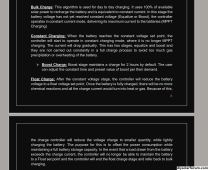New member here, please forgive me if this has been covered before.
I have replaced my AGM battery with a 200AHr LiFePO4 from Renogy.
My MPPT Charge Controller is a 40A Renogy Commander which has no LiFePO4 Charge Settings,
but does have "User Settings" for charging parameters.
Renogy Tech Support has been useless, as all they can do is read from their manual.
The Renogy Battery manual gives me the following Charge Parameter settings as follows:
"Charge/Boost = 14.4V"
"Bulk/Absorbtion = 14.4V"
"Boost Return = 13.2V"
"Over voltage Disconnect = 15V"
"Over voltage Reconnect = 14.2V"
"Low Voltage Reconnect = 12.6V"
"Under voltage Warning = 12.0V"
"Under voltage Shutdown = 10V"
The Charge Controller "User Settings" not mentioned in the batter manual are:
"Boost Time", "Low Voltage Disconnect", "Discharge Limit", "Float Charge" and "Charge Limit"
Can anyone help me with the values for the above User Settings? (TIA)
I have replaced my AGM battery with a 200AHr LiFePO4 from Renogy.
My MPPT Charge Controller is a 40A Renogy Commander which has no LiFePO4 Charge Settings,
but does have "User Settings" for charging parameters.
Renogy Tech Support has been useless, as all they can do is read from their manual.
The Renogy Battery manual gives me the following Charge Parameter settings as follows:
"Charge/Boost = 14.4V"
"Bulk/Absorbtion = 14.4V"
"Boost Return = 13.2V"
"Over voltage Disconnect = 15V"
"Over voltage Reconnect = 14.2V"
"Low Voltage Reconnect = 12.6V"
"Under voltage Warning = 12.0V"
"Under voltage Shutdown = 10V"
The Charge Controller "User Settings" not mentioned in the batter manual are:
"Boost Time", "Low Voltage Disconnect", "Discharge Limit", "Float Charge" and "Charge Limit"
Can anyone help me with the values for the above User Settings? (TIA)




